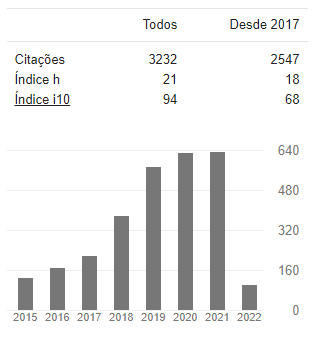Efecto de la adición de caliza a clínquer portland angolano en el comportamiento mecánico de morteros
DOI:
https://doi.org/10.15628/holos.2016.5236Palavras-chave:
caliza, resistencia mecánica, clínquer, morteros, cemento PortlandResumo
En los últimos años la producción de cemento ha ido en aumento fundamentalmente en los países en vías de desarrollo, incrementando las emisiones de CO2 a la atmosfera. Por otra parte, la norma Europea EN 197-1 para la producción de cemento permite incorporar materiales alternativos para disminuir este efecto y a la vez hacer un mejor aprovechamiento de los recursos, así como disminuir el consumo energético durante la producción del clínquer. En este trabajo se evalúa el efecto de la adición de caliza, en distintas proporciones, en la resistencia a la compresión de morteros. Los resultados indican que es posible preparar mezclas en cuya composición se alcance hasta un 20 % de caliza sin que por ello se viole la normativa angolana de control de la calidad del cemento producido. Se presentan los modelos matemáticos que describen el comportamiento o efecto que se produce al adicionar caliza y su influencia en la resistencia a la compresión medida en morteros. Se comprobó a nivel industrial en una planta de cementos angolana que para un 12 % de caliza intermolida con clínquer es posible preparar cemento con valores de resistencia a la compresión dentro de los parámetros establecidosDownloads
Referências
Benachour, Y., Davy, C. A., Skoczylas, F., & Houari, H. (2008). Effect of a high calcite filler addition upon microstructural, mechanical, shrinkage and transport properties of a mortar. Cement and Concrete Research, 38, 727-736. doi: 10.1016/j.cemconres.2008.02.007
Bensted, J. (1980). Some hydration investigations involving portland cement-Effect of calcium carbonate substitution of gypsum. World Cement Technology, 11(8), 395-406.
Bentz, D. P. (2006). Modeling the influence of limestone filler on cement hydration using CEMHYD3D. Cement and Concrete Composites, 28(2), 124-129. doi: 10.1016/j.cemconcomp.2005.10.006
Bonavetti, V. L., Rahhal, V. F., & Irassar, E. F. (2001). Studies on the carboaluminate formation in limestone filler-blended cements. Cement and Concrete Research, 31(6), 853-859. doi: 10.1016/S0008-8846(01)00491-4
Camiletti, J., Soliman, A. M., & Nehdi, M. L. (2014). Effect of limestone addition on early-age properties of ultra high-performance concrete. Construction Materials, 167(2), 65-78. doi: 10.1680/coma.11.00064
CEMBUREAU. (2015). Activity report. Retrieved 10 octubre, 2016, from http://www.cembureau.eu/2015-activity-report
CEN. (2005). EN 196-1, Methods of testing cement – Part1: Determination of strength: European Committee for Standarization.
CEN. (2011). EN 197-1, Cement – Part 1: Composition, specifications and conformity criteria for common cements: European Committee for Standarization.
CEN. (2013). EN 196-2, Method of testing cement - Part 2: Chemical analysis of cement: European Committee for Standarization.
Cyr, M., Lawrence, P., & Ringot, E. (2005). Mineral admixtures in mortars: quantification of the physical effects of inert materials on short-term hydration. Cement and Concrete Research, 35(4), 719-730. doi: 10.1016/j.cemconres.2004.05.030
Chen, J. J., Kwan, A. K. H., & Jiang, Y. (2014). Adding limestone fines as cement paste replacement to reduce water permeability and sorptivity of concrete. Construction and Building Materials, 56, 87-93. doi: 10.1016/j.conbuildmat.2014.01.066
Damtoft, J. S., Lukasik, J., Herfort, D., Sorrentino, D., & Gartner, E. M. (2008). Sustainable development and climate change initiatives. Cement and Concrete Research, 38(2), 115-127. doi: 10.1016/j.cemconres.2007.09.008
Dhir, R. K., Limbachiya, M. C., McCarthy, M. J., & Chaipanich, A. (2007). Evaluation of Portland limestone cements for use in concrete construction. Materials and Structures, 40(5), 459-473. doi: 10.1617/s11527-006-9143-7
Ghrici, M., Kenai, S., & Said-Mansour, M. (2007). Mechanical properties and durability of mortar and concrete containing natural pozzolana and limestone blended cements. Cement & Concrete Composites, 29(7), 542-549. doi: 10.1016/j.cemconcomp.2007.04.009
Githachuri, K., & Alexander, M. G. (2013). Durability performance potential and strength of blended Portland limestone cement concrete. Cement and Concrete Composites, 39, 115-121. doi: 10.1016/j.cemconcomp.2013.03.027
Lothenbach, B., Saout, G. L., Gallucci, E., & Scrivener, K. (2008). Influence of limestone on the hydration of Portland cements. Cement and Concrete Research, 38, 848-860. doi: 10.1016/j.cemconres.2008.01.002
Marzouki, A., Lecomte, A., Beddey, A., Diliberto, C., & Ouezdou, M. B. (2013). The effects of grinding on the properties of Portland-limestone cement. Construction and Building Materials, 48, 1145-1155. doi: 10.1016/j.conbuildmat.2013.07.053
Matschei, T., Lothenbach, B., & Glasser, F. P. (2007). The role of calcium carbonate in cement hydration. Cement and Concrete Research, 37, 551-558. doi: 10.1016/j.cemconres.2006.10.013
Matthews, J. D. (1994). Performance of limestone filler cement concrete. Impact of ENV, 197, 113-147.
Meddah, M. S., Lmbachiya, M. C., & Dhir, R. K. (2014). Potential use of binary and composite limestone cements in concrete production. Construction and Building Materials, 58, 193-205. doi: 10.1016/j.conbuildmat.2013.12.012
Péra, J., Husson, S., & Guilhot, B. (1999). Influence of finely ground limestone on cement hydration. Cement and Concrete Composites, 21(2), 99-105. doi: 10.1016/S0958-9465(98)00020-1
Poppe, A.-M., & Schutter, G. D. (2005). Cement hydration in the presence of high filler contents. Cement and Concrete Research, 35, 2290-2299. doi: 10.1016/j.cemconres.2005.03.008
Ramezanianpour, A. A., Ghiasvand, E., Nickseresht, I., Mahdikhani, M., & Moodi, F. (2009). Influence of various amounts of limestone powder on performance of Portland limestone cement concretes. Cement and Concrete Composites, 31(10), 715-720. doi: 10.1016/j.cemconcomp.2009.08.003
Schneider, M., Romer, M., Tschudin, M., & Bolio, H. (2011). Sustainable cement production—present and future. Cement and Concrete Research, 41(7), 642-650. doi: 10.1016/j.cemconres.2011.03.019.
Sezer, G. I., Goktepe, A. B., Sezer, A., Ramyar, K., Dilek, F. T., & Tuyan, M. (2012). Cement type and the sulfate resistance of PC Mortar. Global Journal on Technology, 1.
Thomas, M. D. A., Hooton, D., Cail, K., Smith, B. A., De Wal, J., & Kazanis, K. G. (2010). Field trials of concretes produced with portland limestone cement. Concrete international, 35, 35-41.
Vernet, N. C., & Noworyta, G. (1992). Mechanisms of limestone fillers reactions in the system {C3A-CSH2-CH-CC-H}: Competition between calcium monocarbo-and monosulfo-aluminate hydrates formation. Paper presented at the 9th International Congress of Cement Chemistry.









































